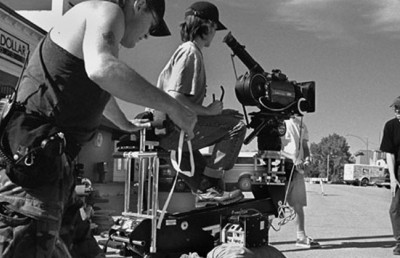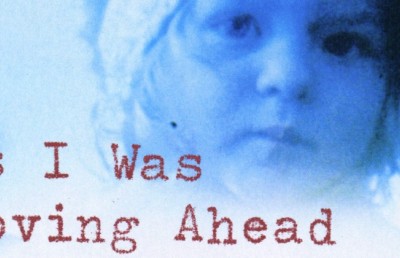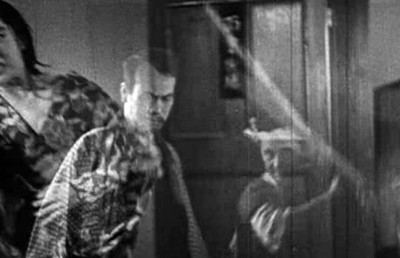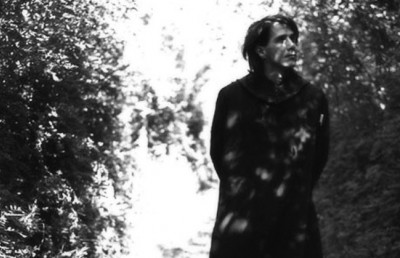FCMM 2001: Sounding Off, Part 2
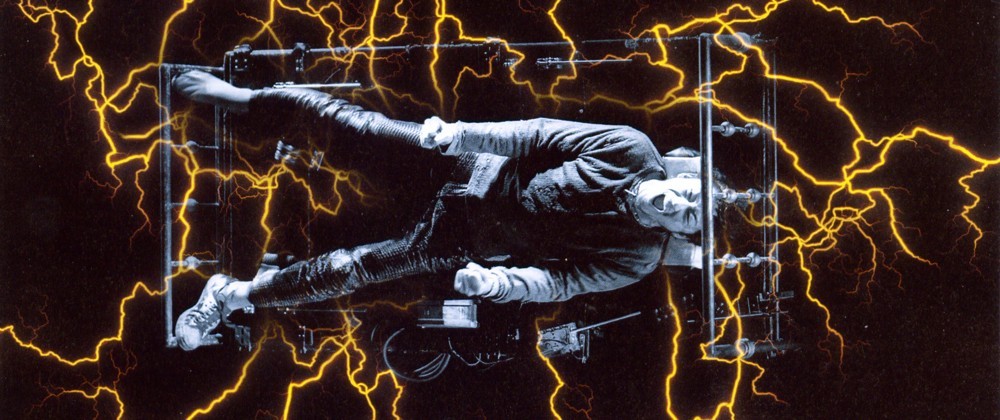
The finest example I’ve seen of applying the concept of the remix to the cinema was at the 1995 edition of the Vancouver International Film Festival. Sogo Ishii was in town to introduce his masterpiece Labyrinth of Dreams, and while he was there he also put on a very special one-time show featuring a two-hour re-editing of many of his films with live musical accompaniment. Sogo manned a massive 360 degree mixing console where he manipulated a vast array of pre-recorded materials, and had his buddies from his own noise band on guitar and drums backing him up. The films were reconstructed to remove all conventional narrative, and the result was a very intense journey through the worlds of this Japanese master filmmaker that extracted the essence of his œuvre and demonstrated how direct juxtapositions between a variety of his films can yield an even more powerful understanding of his works as a whole despite their fragmentation.
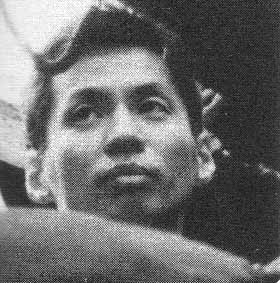
Sogo Ishii
Sogo’s two most recent films have graced Montreal screens in the last little while. His Samurai epic Gojoe played this year’s Fantasia Film Festival (though in the abridged export version), and Electric Dragon 80,000 V proved to be one the highlights of the FCMM. What is most interesting from the perspective of this report is that the film features the electric guitar very prominently in the context of exploring the relationships between humans and electricallypowered technology. The electric guitar perhaps best sums up many of the issues that arise when discussing electronic vs. acoustic music. The electric guitar has found its place in that category of music that is still understood as being dependent upon performance on an instrument. The very notion of what makes a musical instrument just that vs. a piece of technology is very problematic. The electric guitar was one of the first instruments to bridge the gap between the electrical world and that of the traditional instrument. It plays very much like an acoustic guitar, yet for the sound to be heard correctly it must be translated into electrical impulses. But we don’t usually call guitar rock “electronic music,” so somehow the electric guitar has retained its status as traditional instrument in a way that samplers and turntables can’t seem to do.
Electric Dragon 80,000 V tells the tale of two men, each torn between the worlds of flesh and electronic technology, each wandering the city looking for an outlet (so to speak) for their inner conflicts. The hero is a tormented young man who, while climbing a power tower in his childhood, was severely electrocuted. This event left him supercharged and perpetually needing to release the electrical charges now stored within him. Having boxed for a while, obliterating opponent after opponent until he was deemed too dangerous, he then discovers the electric guitar as the ultimate tool for his electrical expression. Having also the gift of communicating with reptiles, he is dubbed the electric dragon. Meanwhile, his nemesis, Thunderbolt Buddha, roams the rooftops with telecommunications surveillance equipment in search of evil-doers to target and eliminate. Half-man half-metal, Thunderbolt Buddha’s metal side culminates in half his head taking the form of the Buddha himself, whose little spire seems to be a focal point for the man’s peculiar talents for transmission interception. His biggest interest, however, seems to be finding the Electric Dragon and putting that wayward energy to rest.
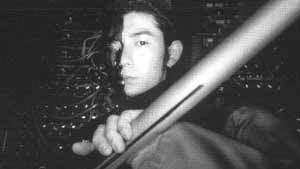
Electric Dragon 80,000V
The two men can be seen as the very embodiment of the dynamic that exists in the relationship between cinema and its perceivers. The Electric Dragon is a being infused with electricity that bursts forth with this energy in spectacular displays of charged light and electrically processed guitar music. Thunderbolt Buddha is wired for the reception of sound and light through his physiology as well as the technological extensions of this physiology. The two are drawn to one another, growing ever closer in their urban meanderings until they finally meet and come together in a dazzling display of the forces that collide and join between opposites that attract. Modern film is dependent upon electric light for its projection and electronic amplification for its sound, light and sound that then enters our bodies, physically stimulating various receptors that transmit the stimulus to the brain where it is transformed back into electrical impulses. As electrically charged beings ourselves, it makes sense that we would experience cinema so powerfully since it seems to provide a perfect fit with many of the physical processes we already have in place for sensory perception.
Our understanding of film is a very technological one. Many films in a festival like this seek to expose the technological nature of that which we experience in the cinema, and Sogo latches on to that idea here by exploring how our relationship with cinema might be a product of the very electrical nature of our beings. The visibility of the technology in Sogo’s film is very important. Wandering the rooftops with dish receivers and the like, the visibility of Thunderbolt Buddha’s sound reception technology matches the visibility of the Dragon’s instrument of electronic sound production. Our ability to comprehend in visual terms a particular technology has a lot to do with what attracts people to it. I believe it is no accident that the turntable, that most visually apparent of sound reproduction technologies, has become the hallmark of musical interest in the materiality of these media. Its visibility is matched by its openness to physical manipulation, and the two go hand in hand to yield a technology that allows itself to move beyond simple reproduction to production in its own right. Though no turntables make it into Electric Dragon 80,000 V, Sogo is well aware of the power of the technologically visible. He taps into our fascination with the technologies that are so clearly extensions of ourselves that they invite interaction to bring them back into unison with the flesh that created them in the first place. This is what electronic music is often about, and the union between flesh and technology through interaction between the two is what the FCMM seems to celebrate more than anything else.
Electric Dragon 80,000 V plays on what has become a sub genre in Japan: the noise-rock 50s punk biker guitar hero film. Sogo takes the energy of films such as Wild Zero (Tetsuro Takeuchi, 2000), brings it into the realm of cyberpunk through clear reference to the iconography of Tsukamoto’s now classic Tetsuo: The Iron Man (1988), all the while filtering it through his own brand of aesthetic mastery. Sogo has a tendency to reinvent genres that he works with. That was certainly the case with Labyrinth of Dreams where he took noir conventions into new territory, and with Gojoe where the Samurai epic transformed into a Sogonian tour through the consciousness of the very forest itself and the spirits that dwell within. As I mentioned earlier as well, Sogo is not afraid to reinvent his own work either, as was the case with his remix performance in Vancouver. In Electric Dragon 80,000 V, Sogo’s reinterpretation of noise rock’s interest in the texture of heavy guitar distortion and cyberpunk’s obsession with technology made flesh demonstrates his desire to explore medium-specific sonic and visual textures as discovered through the interaction between humans and their machines.
The electric guitar is the perfect bridge between electric and acoustic sonic worlds and between humans and electric technology. The guitar as icon of the bridge between musical worlds in the age of electricity was evoked in at least two other FCMM presentations this year. The Media Lounge performance by Rafael Toral featured the use of electric guitars to create sonic textures through the simple vibration of the strings, feedback with amplifiers, and the harmonics that can be produced through both of these methods. Letting the guitars speak for themselves, propped up against their amplifiers, Toral kept his hands on the effects box and mixer to gently coerce the ringing guitar tones into sound sculptures that meandered through various states of change over the course of the set. Toral directly addresses the place of the electric guitar in contemporary music, using it here as a bridge between traditional performance and electronic manipulation the way the same instrument once pushed the boundaries between the acoustic and electrified creation of sound. Unfortunately, as with most shows at the Media Lounge, it was way too loud for me to appreciate the nuances of what Toral was doing. Upon purchasing his Violence of Discovery, Calm of Acceptance CD and listening to it through my Grado headphones, the wonders of subtlety that Toral coaxes from his guitars came through in their true glory. The fact that I could enjoy his work so much more as a recording than as a performance (something that has been happening to me more and more as of late) really forces me to question how it is that I understand music as a conglomerate of human instrumental manipulation and studio recording techniques. For those wholike to listen to music at home, I highly recommend this disc.
Another musician who once pushed the envelope of what the electric guitar is all about was celebrated in Blue Wild Angel: Jimi Hendrix Live at the Isle of Wight. This documentaryprovided festival audiences with a solid reminder of one of the people directly responsible for changing the way we understood music in the electrical age, and emphasized how Hendrix was much more interested in the art of the studio rather than live performance. Through his fairly radical use of the electric guitar and his deep expressive capabilities, Hendrix demonstrated that the merging of human virtuosity and electronic technology can be as soulful as any art could ever want to be.
However, it is important to note that this film is more a document of Jimi’s shortcomings than it is a testimony to his genius. Though the FCMM catalogue states boldly that this film presents Hendrix “at the peak of his form,” the footage we see heavily suggests otherwise. And filmmaker Murray Lerner knew it, as is evidenced by his inclusion of an interview with one of Hendrix’s producers stating that the guitarist did not really want to go on tour, but needed the money to carry on with his true love: studio recording. How anyone could miss this fact in watching Hendrix on stage at the Isle of Wight is a mystery to me. Rifling through his hits like Val Kilmer singing “Light my Fire” in Oliver Stone’s The Doors, an air of frustrated indifference clearly permeating his presence, Jimi so much as announced to the audience midway through the set that he was going to “start over,” clearly illustrating the fact that he was not particularly satisfied with the way things were going. And it didn’t really get any better, with Hendrix at one point leaving the stage to talk with people in the back while performing a guitar solo, and finally ending the whole deal by throwing his guitar down like a cigarette butt and spewing something tothe effect of “better luck next time” to all his adoring fans. While I realize that many prima donna type artists could act as Jimi did while still having delivered a good show (Deep Purple’s Ritchie Blackmore comes to mind), I defy anyone to tell me that this was the case here. Not being a Hendrix fan for his music per se, but recognizing his genius and his contribution to much of the music I love today, this concert footage did nothing to make me want to explore his work further. Listening to some of his later albums, on the other hand, shows me quite clearly that he really had something going on in the studio. Not to mention the fact that Miles Davis, pioneer in the use of electric guitar in jazz and who was well into some of the most radical studio constructions of the day with recordings like “Go Ahead John” on Big Fun (on which John McLaughlin gives one of the most heart-stopping performances of his illustrious career), had actually booked some studio time with Hendrix for a couple weeks after the latter died. This simultaneous recognition of Hendrix’s virtuosity on the electric guitar and his power in the studio by one of the great masters of our age clearly demonstrates that Jimi was going places, places not even glimpsed in performances like the one we witness in Blue Wild Angel.
As an informational documentary the film is horribly sloppy, stringing together a hodgepodge of talking head extracts from the original Isle of Wight documentary and a few other Jimi relatedsources that go almost nowhere and serve only to make a feature-length film out of the hour or so of live concert footage that is clearly meant to be the film’s raison d’être. But brief moments like the above-mentioned interview do put Hendrix into an important context. Another such snippet came in the form of Jimi’s appearance on the Dick Cavett show, describing his philosophy of the “electric church” whereby people’s souls can be reached through the manipulation of electrical flow. There is a rich history of supernatural beliefs that have arisen around the development of electricity and its related technologies, and I believe that one of the most powerful attractions of music created with electricity is this sense that somehow we can be reached through the powerful energy inherent in both the creation and reception of such music. As with Sogo’s interest in the human body as electrical being and the texture of electrical sound and light in Electric Dragon 80,000 V, Hendrix’s electric church illustrates the same sense that our interest in self-expression through electrical means is a function of our own inherent electrical nature. Hendrix’s greatest achievement, I believe, was voyaging deeper into the electric guitar’s specific sonic characteristics than had been done before, and he did it through an almost symbiotic relationship with his guitar that allowed his own energy to flow through it and vice versa, and in turn allowing these energies to flow into us.
The exploration of sound for its own sake rather than as a function of composition is another key founding concept that many of the works presented in FCMM this year took to heart. Rafael Toral’s performance was clearly interested in the sound that can be created from the vibrations of his guitars without ever touching the strings. Another interestinrole technology can play in generating sound not generally desired from that technology was a double presentation of Gameboy Pocket Noise and Symphony #2 for Dot Matrix Printers. In the Gameboy piece, Christophe Kummerer uses software he developed to turn the Nintendo pocket unit into an electronic sound generator. Apparently, the sounds emitted are a combination of intentional sampling of the low-fi electronic noises the unit can emit on its own and unintentional glitches created by the buggy software. This is theoretically interesting and carries on the tradition in electronic music of exploring the imperfections of sound reproduction technology and exploiting them for their ownunique sonic qualities. Unfortunately, the result here is simply an onslaught of loud sustained tones that he gently layered and mixed in and out of to create some flow. I aminterested in experiencing sustained tones to the point where they reveal a constant changeamidstthe continuum, and even here there were moments where rhythmic pulses would emerge from the sounds as a result of the cycling of their frequencies and their interaction with the other frequencies they are blended with. But ultimately the experience is unsatisfying. We live in an age where far more is possible with a similar amount of simplicity and conceptual thought behind it.
Much more exciting was the second act, Symphony #2 for Dot Matrix Printers by Montreal based duo The User. Having set up an array of 15 dot matrix printers fitted with microphones and cameras, they then let loose a series of programs written to get the printers working in unison to create all manner of rhythms and even melodies through the nuances of their most particular sonic characteristics. The piece even exploits the differences in the sounds between different varieties of dot matrix printer, with solos being taken by different units from time to time so that we can really appreciate the distinct qualities of their sounds. While much of the sound exploited is from the patterns that can be created simply by printing different combinations of letters and lengths of words etc., every possible function of the printers is utilized for its musical potential. What I think is most interesting about the piece overall is that it takes the convention of symphonic composition, with all its trappings of supreme organization and divine perfection, and places it within the context of glitch music, that which seeks to take the unwanted sounds of quotidian technological experience and highlight them for their own brand of musical beauty. However, the composition as a whole falls far short of the grandeur to which even a modest symphony can soar to, and ultimately feels like a first step towards something much greater down the road, something I hope they are working on right now.
These two performances draw on the hard fact of electronically generated noise that fills the daily lives of urbanites such as myself, and plays with the idea that there may be more to such noise than simply the irritation created by unwanted technological byproduct. Electronic presence can be understood as a powerful force that infiltrates our consciousness on a daily basis, constantly affecting the way we interact with our environment and shaping our experience as human beings.
In Jia Zhang-Ke’s Platform, the importance of music (and the technology that brings it) in the conceptual evolution of mainland China’s youth is a major theme. Zhang-Ke’s almost completely static camera and the very few instances of extra-diegetic music make the frequent use of diegetic music stand out quite remarkably. The film’s depiction of the struggle between communist ideologies and Western sensibilities comes largely through the country’s youth being influenced by non-traditional music. Simple technologies like portable tape recorders become vehicles of resistance and ultimate escape for the film’s protagonists, teenagers who want out of the communist life and into the urban centers where Westernization is more prevalent. The film’s title comes from a song in which the lyrics speak of the long platforms on the trucks “carrying my love away from me,” symbolizing the escape to the big city that the teenagers finally make on just such a truck. Upon their arrival, the first thing they do is dance to modern techno-pop. Platform ends on a dubious note, however, with a shot of one of the couples who left for the city some years later, he passed out in a chair in the corner, she hovering over a boiling pot with child in hand. The scene is very bleak, the ruckus of urbanity right outside their door, a sense of the banality of the situation leaving the feeling that perhaps they might have been happier in the countryside from which they came.
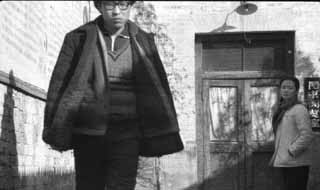
Platform
The concept of electronic presence as it relates to the power of music in people’s everyday lives is also prevalent in Hou Hsiao-Hsien’s latest effort Millenium Mambo. The film features the art of turntablism quite prominently, not only as a the practice of one of the main characters but also as a function of the film’s overall structure, both narrative and formal. The story finds a young woman, Vicky, in a bad relationship with an abusive nightclub DJ named Hao Hao who spends more time practicing his mixing in the living room than he does paying attention to her. Clearly unhappy, Vicky decides to get out, and finds a solace of sorts with Jack, a well-off nightclub owner, who puts her to work in his bar and provides her with good living conditions. However, Vicky finds herself smothered by the nightclub environment. With Hao Hao at least she doesn’t have to spend any time in the clubs he plays, but has to endure his behaviour. Torn between these two worlds, she alternates between them, crossing over between Jack and Hao Hao over the course of many years. Her only moments of peace come when she travels with friends to the Yubari film festival in Japan. The mid-February festival finds the town draped in snow, providing an otherworldly sense of limbo that Vicky enjoys enough to find herself back there again at the end of the film. After swirling around for her whole life between unhappy circumstances, the film ends with a very long shot of Yubari in the comforting blanket of the stunningly beautiful snow.
I suggest that this alternation between two worlds and the finding of ultimate peace in a limbo state caught somewhere in between is a structure that patterns itself after the processes of DJ turntable mixing. Basic club mixing consists of a two-turntable rig meditated by a mixer that allows volume fading between the two. As Vicky’s two worlds are made up of either Hao Hao the club DJ or Jack the club owner, her experience is inevitably one of feeling lost within the dungeons of loud smokey nightlife and its progenitors. Too much of this life can certainly make your head spin, and Vicky finds herself in a very circular pattern indeed, extending the mix of her life indefinitely through constant alternation between these two similar worlds. If we consider the two worlds to be represented by the two turntables of a DJ rig, and the mixer as that middle ground that has the power to suspend the relationship between the two indefinitely, then the film indeed can be seen as being the embodiment of a typical DJ set, carrying on its repetitive circular rhythms through the alternation between an endless array of similar records.
The film employs some formal devices that are also reminiscent of DJ practices. Most notably, Vicky’s narration of the film often relates events that she speaks of as having already happened as though placing the present events seen on screen in a historical context. Yet frequently it is discovered that the events on-screen, assumed to be taking place after the events Vicky describes, are actually those same events, now playing out before our eyes after having had the images planted in our minds by the narration. This strategy has the effect of creating a kind of disruption of linear flow, almost a timelessness that is enhanced by the seemingly never-ending state of dismay that Vicky herself experiences. In addition to extending musical flow by seamlessly joining records together, DJs also create disruptions in flow through scratching techniques, and with the repeating of isolated segments a new kind of flow can emerge from the endless repetition of the same moments.
Another kind of timelessness emerges, however, in the Yubari segments. Yubari ends up being a place where the trouble of her other lives is forgotten and the bliss of a white paradise encompasses her. As Mekas states at one point in As I Moved Ahead, “I have to film snow; paradise is full of snow.” Yubari becomes for Vicky the eternity of heaven vs. the eternity of hell she experiences in her other lives. Yubari is for Vicky what the mixer could be for the records – a space between the two worlds that allows the alternation to stop if desired, to hold both worlds together in a space that allows something new to emerge, that which allows timelessness to occur, a moment to extend for as long as one likes. I’m reminded here of something T.S. Elliot once wrote: “At the still point of the turning world. Neither flesh nor fleshless. Neither from nor towards, at the still point, there the dance is. Where past and future are gathered. Neither movement from nor towards, Neither ascent nor decline. Except for the point, the still point” (1). I believe that the turntable principles at work in Millenium Mambo echo Elliot’s poetry by bringing to the fore the timelessness that can be created through the circling of things around a center. Pauline Oliveros’ “Deep Listening” might be a way of putting Elliot’s verse in the context of the physical experience of timelessness through sound, where the past, present, and future all dance together in the stillness of the center as experienced by that person who occupies the central space. As described, Vicky’s life circles around between two worlds until she finds solace in the unmoving space of the Yubari center. It is in the center that the past and future are put on hold as a DJ might suspend both the beginnings and ends of the records being played through the manipulation of the mixer: that still point in the mixing that echoes the hole in the middle of the turning record itself.
There is a long history of turntable presence in the cinema, as well as every other manifestation of technology that can be imagined. Those films that seek to explore these technologies by incorporating them into their own structures as well as presenting them onscreen interest me a great deal. A film that takes a particular technology as the basis for its narrative, aesthetic, and formal organization and propels it to an extreme level is Virgil Widrich’s short Copy Shop. The film features a man who, while making some photocopies, accidentally copies himself. The copied man then becomes manifest in the real world, and the two together find themselves in the copy shop. The two then accidentally copy themselves again, and this continues until the streets run thick with duplicates of the man. I’ve never seen so many doubles in a live action film before. The digital composite work that must have been necessary to create a frame with dozens of the same individual running around is mind-boggling. But it doesn’t stop there. The entire film has the visual texture of a grainy black and white photocopy. This effect was achieved by digitally printing each finished frame in black and white on paper after theediting was complete, and then re-photographing each page in 35mm. The effect is truly remarkable. The film succeeds in taking the concept of a world replete with copy technology, exploring it through the material deficiencies that almost always accompany any act of copying while presenting a narrative of the copy gone mad, taking over the very functions of humanity, robbing us of our individuality. The film is chock full of copies from the production process to the visual aesthetic and on into the narrative. It is truly a work that questions the absurdity of modern copy technology gone crazy while celebrating both the mechanical processes of such copying and the nuances of the aesthetic it produces. As complete an achievement as I’ve had the pleasure of experiencing.
Finally, I save the best for last. Béla Tarr’s latest film Werckmeister Harmonies remains faithful to a dying cinematic tradition while producing a work that perfectly sums up many of the issues that this report has been concerned with. This stunning two and a half hour film contains 39 shots, roughly one shot per scene. Those of us who have seen his earlier Satantango had some idea what to expect; these aren’t static shots that push the limits of what we can endure in terms of non-action. Tarr’s camera roams very precisely through all manner of movement, carving out the space that surrounds his characters with a grace and majesty that certainly recall the work of Tarkovsky. His shot set-ups are heroic in their scope and ambition, and he pulls them off marvelously.
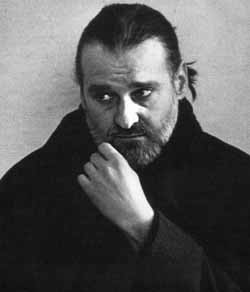
Béla Tarr
The story, very briefly, involves the young Mr. V foretelling the end of the world to a group of drunkards in the tavern of a desolate Hungarian town. Upon his walk home later that night, he witnesses the arrival of a huge truck that sets itself up in the town square the following morning, boasting of the majestic creature of the sea contained within. The contents turn out to be a huge stuffed whale, decaying and decrepit. Mr. V is the only one to actually enter thetruck for a gander, but the rumors of the whale’s presence in the town create speculation as to what the arrival of such a monstrous being might mean. Placing the whale in the context of the impending apocalypse, the town is incited to riot out of desperation for their dismal lot. One of the most amazing sequences (consisting of two shots) involves the riotous mob entering a hospital and tearing it to shreds while the camera moves with them in and out of rooms, up and down steps, circling around various individual acts of violence while simultaneously maintaining a sense of the collective chaos.
Like most of the films discussed here, Werckmeister Harmonies has music and sound at the forefront of its conceptual organization. The film’s title comes from Western music’s development of the twelve-tone scale, designed as a way of tempering the relationships between the sonic possibilities of the natural world and creating an organization of them to emulate the divine organization of the gods. One of the film’s main characters, I’ll call him Mr. G, spends most of his time philosophizing over music theory into a microphone in his room next to his piano. The first time he is seen he is speaking of the folly of humankind’s attempt to recreate the perfection of the gods on Earth through twelve-tone temperament, and laments the fact that all the great masterpieces of Western music have been built upon the fraudulent relationships between tones that were invented for the purpose of pretending to be something they are not. If we consider Mr. G’s comments in light of the town’s reaction to the presence of the whale, something very interesting becomes evident. The whale is an example of a divine masterpiece, one of nature’s finest creations. Yet this natural masterpiece is not respected as such by the townspeople. Instead the whale is treated as an abomination, a sign of the apocalypse and nature’s revenge on humankind. In a society that reveres the concept of the masterpiece as human creation instead of finding perfection where it actually exists, in the wonders of nature herself, only bad things can result.
The use of the twelve-tone system as the example of humankind’s warped understanding of what makes a masterwork is not simply a convenient metaphor. Tarr’s film is imbued with a musical presence that reveals the director’s deep interest in the relationships humans have with the greatest of all arts: the organization of sound. Most notably, Mihaly Vig’s score is serenely beautiful. But Tarr explores other issues surrounding our understanding of sound as well. In a pristinely simple gesture Tarr demonstrates a questioning of the relationship between performance and recording technologies as it relates to our concept of music. Upon one of the film’s several entries into Mr. G’s room, we hear the sound of piano music. At first it might be believed that the music is part of the extra-diegetic score. However, we are soon reminded that Mr. G owns a piano. As Mr. G’s piano becomes visible, however, it is seen that no-one is playing it. Before we go back to thinking the music is coming from without, however, our attention is called to the reel-to-reel tape machine next to it and we understand that the music is indeed diegetic but pre-recorded in nature. Lynch’s theatre of silence comes to mind here as Tarr gives us his own little demonstration of the nuances of film sound, one camera move simultaneously leading us in and out of believing that the music we hear is extra-diegetic, diegetic, live performance, and recording.
Later in the film a couple dances to some brisk marching music heard over the radio. The location then changes, but the same music is heard coming through another radio, this time being enjoyed by two children boisterously banging pots and yelling in enthusiastic engagement. The children illustrate the clear joy that can be had in the experience of noise. Not only do they keep rhythm with pot clanging, one of them experiments with the physics of sound wave propagation by yelling into a fan while altering the speed of the blades to create nuances in the transmission of his voice. This interest in sound for its own sake within a film that takes as its subject matter the questioning of Western musical organization makes Werckmeister Harmonies as topical as one could hope to be in this festival.
Most telling in the film, though, is the fact that Mr. G separated from Mrs. G so that he could devote all his time to the study of the piano despite his frustration with the instrument’s inherent design around the twelve-tone system. His own preoccupation with musical mastery and the philosophical understanding of that mastery prevents him from experiencing one of the true masterpieces of the natural world: the bond of love between two people, and the flow of emotional communication that can result from that love. His experience of music and sound comes through the domestic technologies of his piano and tape-recorder, and the experience of his isolation becomes bound up in his psychological and physical experience of the domestic space in which he carries out his life. Mr. G’s understanding of humankind’s failure to acknowledge the perfection of nature does not prevent him from falling into the same trap, and the film’s hopelessness stems from all the townspeople suffering the same fate. Together they may riot, but they are each alone in their desolation and despair.
I think that the questioning of what makes a masterwork might be the ultimate question posed by new technologies, and is certainly one of the predominant questions that FCMM sets out to explore each year. I’ve heard Werckmeister Harmonies criticized for its overt formalism and fervent adherence to technical brilliance. These characteristics are often the hallmarks of what are considered to be cinematic masterpieces, and many feel that this understanding of cinematic mastery is outdated in the digital age. I find it very interesting that Tarr straddles the line between two worlds here with his clear mandate to point out the underlying faults behind Western conceptions of musical mastery and modern humanity’s abhorrence of the natural world while simultaneously adhering to some of the strictest codes of the cinema’s version of masterly organization. Furthermore, his presence as auteur is one of the strongest at work in the cinema today, another throwback to an age that might be slipping away in the wake of new understandings of artistic practice. I’m torn, since I truly love works like Tarr’s that revel in the intricacies of their medium, while this same revelry can be seen at work in so many other areas that do not place themselves in the realm of the traditional masterpiece the way Tarr does.
There is no doubt in my mind that right now is one of the most exciting times in which to be alive. All eras have their shifts in the evolution of art, but I’ll take the current shifts over any that have come before now. The world is poised on the edge of some major breakthroughs. I can feel it. Once a certain balance is achieved between the rush of new technological energy and the presence of mind that accompanies more established forms, I believe a rich age of self-expression will burst forth, an age of completeness stemming from true symbiotic relationships between mediators and their mediums. And I have no doubt that Montreal will be a focal point for this burst through its International Festival of New Cinema and New Media.
Notes:
1 – TS Elliot in Swenson, David. Ashtanga Yoga: The Practice Manual. Houston: Ashtanga Yoga Productions, 1999:241.
(FCMM 2001: Sounding Off, Part 1)



